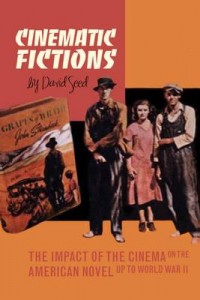Cinematic Fictions: The Impact of the Cinema on the American Novel up to the Second World War by David Seed (Liverpool University Press, 2009). ISBN 978-1846312120 (hardback), £65
 About the reviewer: David Brauner is Reader in English and American literature at the University of Reading and Departmental Director of Research. He has published widely on twentieth-century Jewish literature and contemporary American fiction and is the author of three books: Post-War Jewish Fiction: Ambivalence, Self-Explanation and Transatlantic Connections (2001), Philip Roth (2007) and Contemporary American Fiction (Edinburgh University Press, 2010). For details of his other publications, visit David Brauner Further Publications.
About the reviewer: David Brauner is Reader in English and American literature at the University of Reading and Departmental Director of Research. He has published widely on twentieth-century Jewish literature and contemporary American fiction and is the author of three books: Post-War Jewish Fiction: Ambivalence, Self-Explanation and Transatlantic Connections (2001), Philip Roth (2007) and Contemporary American Fiction (Edinburgh University Press, 2010). For details of his other publications, visit David Brauner Further Publications.
For much of his distinguished career, David Seed has worked at the interface between popular and ‘serious’ culture. The author of a number of important books on science fiction, and a study of the cult novelist and screenplay writer, Rudy Wurlitzer, Seed’s new book boldly deconstructs the barriers between high and low culture by demonstrating the pervasive presence of the cinema in American fiction from the late nineteenth century to the start of the Second World War. Discussing a wide range of writers, from those, such as William Faulkner and F.Scott Fitzgerald, who wrote Hollywood screenplays, to those, such as Stephen Crane, who had no direct involvement with cinema, but whose work anticipated cinematic techniques and displayed ‘a proto-cinematic awareness of movement’, Cinematic Fictions is a compelling, informative and thoroughly researched book that will be invaluable to students and teachers of American fiction and film, as well as modernist literature and culture.
 The originality of the book lies both in the choice of material and the methodological approach to it. There are illuminating discussions of canonical novels that were also made into famous films, such as A Farewell to Arms, The Great Gatsby, An American Tragedy and The Grapes of Wrath, but Seed provocatively juxtaposes these with equally compelling and detailed readings of neglected modernist texts such as ee cummings’ The Enormous Room, H.D.’s Palimpsest and Tom Kromer’s Waiting for Nothing. Among other things, then, Seed’s book implicitly redraws and extends the parameters of both the literary and cinematic canons. Although the subtitle of the book suggests that it will trace ‘the impact of the cinema on the American novel up to the second world war’, Seed in fact emphasises throughout that the relationship between the film and the novel is reciprocal and dynamic - ‘an interchange between the media’ – rather than a one-way street. Indeed, Seed interprets ‘influence’ in its broadest sense. He deals both with direct encounters between novelists and film-makers (including a fascinating chapter on the collaboration between the great Russian director Sergei Eisenstein and the American realist novelist, Theodore Dreiser) and oblique transactions, such as ‘the discourse of apertures, angles and optical instruments’ that manifests itself in Henry James’ famous preface to The Portrait of a Lady, which Seed suggests ‘anticipates the cinema in projecting a narrative assembled out of partial visual views’.
The originality of the book lies both in the choice of material and the methodological approach to it. There are illuminating discussions of canonical novels that were also made into famous films, such as A Farewell to Arms, The Great Gatsby, An American Tragedy and The Grapes of Wrath, but Seed provocatively juxtaposes these with equally compelling and detailed readings of neglected modernist texts such as ee cummings’ The Enormous Room, H.D.’s Palimpsest and Tom Kromer’s Waiting for Nothing. Among other things, then, Seed’s book implicitly redraws and extends the parameters of both the literary and cinematic canons. Although the subtitle of the book suggests that it will trace ‘the impact of the cinema on the American novel up to the second world war’, Seed in fact emphasises throughout that the relationship between the film and the novel is reciprocal and dynamic - ‘an interchange between the media’ – rather than a one-way street. Indeed, Seed interprets ‘influence’ in its broadest sense. He deals both with direct encounters between novelists and film-makers (including a fascinating chapter on the collaboration between the great Russian director Sergei Eisenstein and the American realist novelist, Theodore Dreiser) and oblique transactions, such as ‘the discourse of apertures, angles and optical instruments’ that manifests itself in Henry James’ famous preface to The Portrait of a Lady, which Seed suggests ‘anticipates the cinema in projecting a narrative assembled out of partial visual views’.
Seed’s new book boldly deconstructs the barriers between high and low culture ...
In his introduction, Seed explicitly rejects the model of appropriation of literary works by some film theorists, warning that his study is ‘not an exercise in transposing the critical discourse of film onto literary material’. Equally, Seed refuses to treat films as ‘visual texts’; for the most part, he avoids discussing cinematic adaptations of novels altogether, preferring to trace the ways in which cinematic tropes manifest themselves in fiction. The book covers an impressive range of authors and topics, from the modernist experiments of Gertrude Stein and perspective experiments of William Faulkner, to the naturalism of Dos Passos, Dreiser and Steinbeck, through to the surrealism of Henry Miller and Anais Nin and the grotesque satire of Nathanael West, but a constant theme is the ambivalence of American authors towards a medium for which they often expressed scepticism, cynicism, or even disdain, but which they also courted, envied and even revered.
Cinematic Fictions provides a nuanced, detailed and penetrating account of how this ambivalence produced a corpus of fiction that both advertised and disguised its debt to cinema.
David Brauner